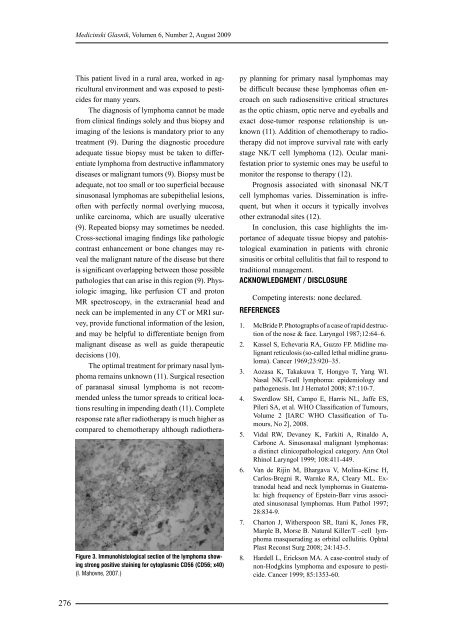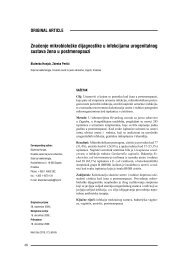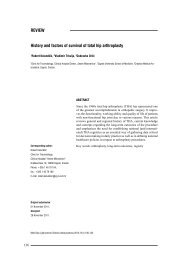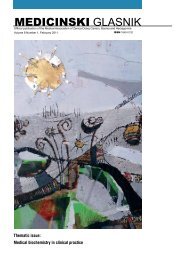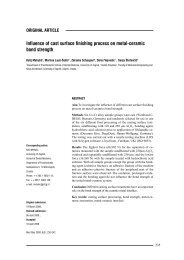MEDICINSKI GLASNIK
MEDICINSKI GLASNIK
MEDICINSKI GLASNIK
Create successful ePaper yourself
Turn your PDF publications into a flip-book with our unique Google optimized e-Paper software.
276<br />
Medicinski Glasnik, Volumen 6, Number 2, August 2009<br />
This patient lived in a rural area, worked in agricultural<br />
environment and was exposed to pesticides<br />
for many years.<br />
The diagnosis of lymphoma cannot be made<br />
from clinical findings solely and thus biopsy and<br />
imaging of the lesions is mandatory prior to any<br />
treatment (9). During the diagnostic procedure<br />
adequate tissue biopsy must be taken to differentiate<br />
lymphoma from destructive inflammatory<br />
diseases or malignant tumors (9). Biopsy must be<br />
adequate, not too small or too superficial because<br />
sinusonasal lymphomas are subepithelial lesions,<br />
often with perfectly normal overlying mucosa,<br />
unlike carcinoma, which are usually ulcerative<br />
(9). Repeated biopsy may sometimes be needed.<br />
Cross-sectional imaging findings like pathologic<br />
contrast enhancement or bone changes may reveal<br />
the malignant nature of the disease but there<br />
is significant overlapping between those possible<br />
pathologies that can arise in this region (9). Physiologic<br />
imaging, like perfusion CT and proton<br />
MR spectroscopy, in the extracranial head and<br />
neck can be implemented in any CT or MRI survey,<br />
provide functional information of the lesion,<br />
and may be helpful to differentiate benign from<br />
malignant disease as well as guide therapeutic<br />
decisions (10).<br />
The optimal treatment for primary nasal lymphoma<br />
remains unknown (11). Surgical resection<br />
of paranasal sinusal lymphoma is not recommended<br />
unless the tumor spreads to critical locations<br />
resulting in impending death (11). Complete<br />
response rate after radiotherapy is much higher as<br />
compared to chemotherapy although radiothera-<br />
Figure 3. Immunohistological section of the lymphoma showing<br />
strong positive staining for cytoplasmic CD56 (CD56; x40)<br />
(I. Mahovne, 2007.)<br />
py planning for primary nasal lymphomas may<br />
be difficult because these lymphomas often encroach<br />
on such radiosensitive critical structures<br />
as the optic chiasm, optic nerve and eyeballs and<br />
exact dose-tumor response relationship is unknown<br />
(11). Addition of chemotherapy to radiotherapy<br />
did not improve survival rate with early<br />
stage NK/T cell lymphoma (12). Ocular manifestation<br />
prior to systemic ones may be useful to<br />
monitor the response to therapy (12).<br />
Prognosis associated with sinonasal NK/T<br />
cell lymphomas varies. Dissemination is infrequent,<br />
but when it occurs it typically involves<br />
other extranodal sites (12).<br />
In conclusion, this case highlights the importance<br />
of adequate tissue biopsy and patohistological<br />
examination in patients with chronic<br />
sinusitis or orbital cellulitis that fail to respond to<br />
traditional management.<br />
ACKNOWLEDGMENT / DISCLOSURE<br />
Competing interests: none declared.<br />
REFERENCES<br />
1.<br />
2.<br />
3.<br />
4.<br />
5.<br />
6.<br />
7.<br />
8.<br />
McBride P. Photographs of a case of rapid destruction<br />
of the nose & face. Laryngol 1987;12:64–6.<br />
Kassel S, Echevaria RA, Guzzo FP. Midline malignant<br />
reticulosis (so-called lethal midline granuloma).<br />
Cancer 1969;23:920–35.<br />
Aozasa K, Takakuwa T, Hongyo T, Yang WI.<br />
Nasal NK/T-cell lymphoma: epidemiology and<br />
pathogenesis. Int J Hematol 2008; 87:110-7.<br />
Swerdlow SH, Campo E, Harris NL, Jaffe ES,<br />
Pileri SA, et al. WHO Classification of Tumours,<br />
Volume 2 [IARC WHO Classification of Tumours,<br />
No 2], 2008.<br />
Vidal RW, Devaney K, Farkiti A, Rinaldo A,<br />
Carbone A. Sinusonasal malignant lymphomas:<br />
a distinct clinicopathological category. Ann Otol<br />
Rhinol Laryngol 1999; 108:411-449.<br />
Van de Rijin M, Bhargava V, Molina-Kirsc H,<br />
Carlos-Bregni R, Warnke RA, Cleary ML. Extranodal<br />
head and neck lymphomas in Guatemala:<br />
high frequency of Epstein-Barr virus associated<br />
sinusonasal lymphomas. Hum Pathol 1997;<br />
28:834-9.<br />
Charton J, Witherspoon SR, Itani K, Jones FR,<br />
Marple B, Morse B. Natural Killer/T –cell lymphoma<br />
masquerading as orbital cellulitis. Ophtal<br />
Plast Reconst Surg 2008; 24:143-5.<br />
Hardell L, Erickson MA. A case-control study of<br />
non-Hodgkins lymphoma and exposure to pesticide.<br />
Cancer 1999; 85:1353-60.


